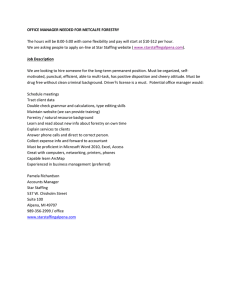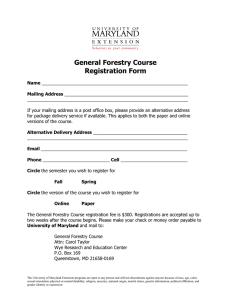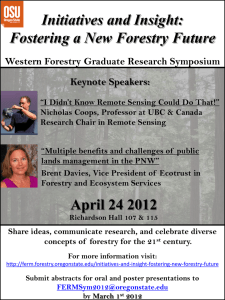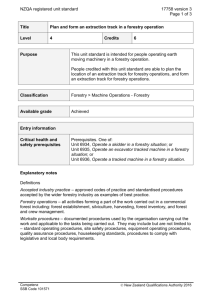NZQA registered unit standard 22994 version 3 Page 1 of 5
advertisement
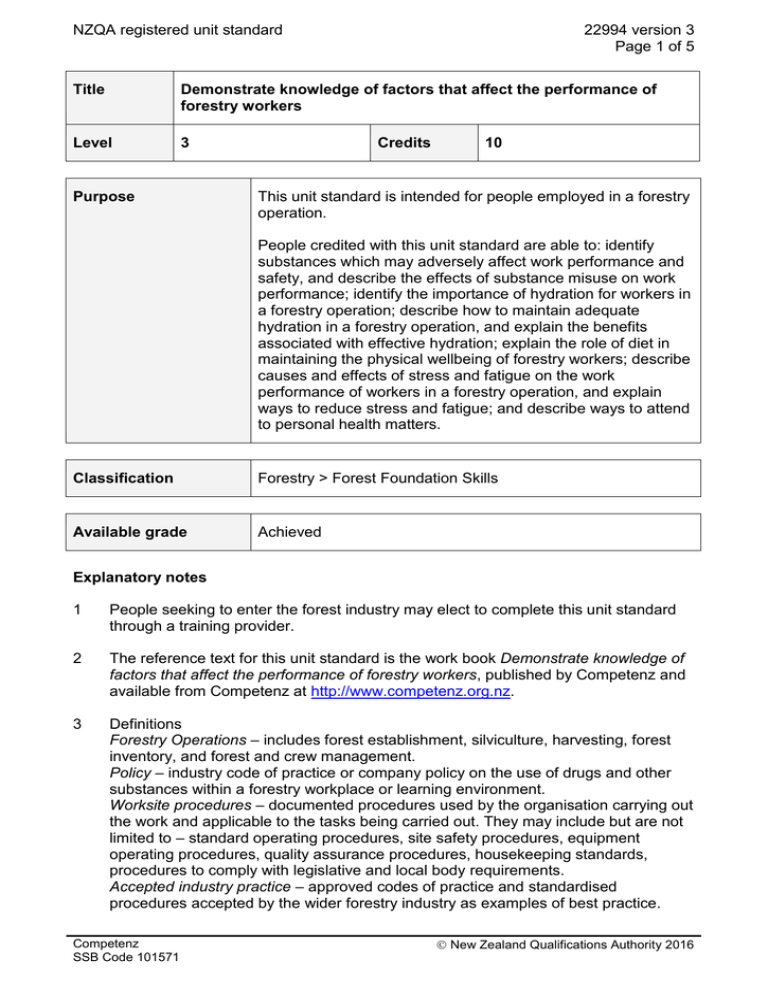
NZQA registered unit standard 22994 version 3 Page 1 of 5 Title Demonstrate knowledge of factors that affect the performance of forestry workers Level 3 Purpose Credits 10 This unit standard is intended for people employed in a forestry operation. People credited with this unit standard are able to: identify substances which may adversely affect work performance and safety, and describe the effects of substance misuse on work performance; identify the importance of hydration for workers in a forestry operation; describe how to maintain adequate hydration in a forestry operation, and explain the benefits associated with effective hydration; explain the role of diet in maintaining the physical wellbeing of forestry workers; describe causes and effects of stress and fatigue on the work performance of workers in a forestry operation, and explain ways to reduce stress and fatigue; and describe ways to attend to personal health matters. Classification Forestry > Forest Foundation Skills Available grade Achieved Explanatory notes 1 People seeking to enter the forest industry may elect to complete this unit standard through a training provider. 2 The reference text for this unit standard is the work book Demonstrate knowledge of factors that affect the performance of forestry workers, published by Competenz and available from Competenz at http://www.competenz.org.nz. 3 Definitions Forestry Operations – includes forest establishment, silviculture, harvesting, forest inventory, and forest and crew management. Policy – industry code of practice or company policy on the use of drugs and other substances within a forestry workplace or learning environment. Worksite procedures – documented procedures used by the organisation carrying out the work and applicable to the tasks being carried out. They may include but are not limited to – standard operating procedures, site safety procedures, equipment operating procedures, quality assurance procedures, housekeeping standards, procedures to comply with legislative and local body requirements. Accepted industry practice – approved codes of practice and standardised procedures accepted by the wider forestry industry as examples of best practice. Competenz SSB Code 101571 New Zealand Qualifications Authority 2016 NZQA registered unit standard 22994 version 3 Page 2 of 5 Outcomes and evidence requirements Outcome 1 Identify substances which may adversely affect work performance and safety, and describe the effects of substance misuse on work performance. Evidence requirements 1.1 Illegal substances that adversely affect work performance and safety are identified and the adverse effects are described in accordance with the reference text. Range 1.2 evidence of three illegal substances is required. Legal substances that may adversely affect work performance and safety are identified in accordance with the reference text. Range evidence of three legal substances is required. 1.3 Policy related to the use, misuse, and abuse of substances by an employee is explained in accordance with the reference text and accepted industry practice. 1.4 Behaviours which may indicate a person is misusing a substance in a way which is likely to affect work performance are identified. Range 1.5 evidence of three behaviours is required. The action to be taken if a workmate is suspected to be under the influence of a legal or illegal substance in the workplace is explained in accordance with worksite procedures and accepted industry practice. Outcome 2 Explain factors affecting fluid loss for workers in a forestry operation. Evidence requirements 2.1 Forestry operations are described in terms of their impact on fluid loss Range operations include – planting, pruning, tree felling, breaking out, machine operating, quality control, plotting. 2.2 Seasonal changes, climatic differences, and temperature extremes are described in terms of their impact on fluid loss. 2.3 Different rates of fluid loss for non-forestry activities are compared in terms of the amount lost due to physical activity. Range Competenz SSB Code 101571 non-forestry activities include – timber grader, rugby player, office worker, truck driver, road cyclist, boxer. New Zealand Qualifications Authority 2016 NZQA registered unit standard 22994 version 3 Page 3 of 5 Outcome 3 Describe how to maintain adequate hydration in a forestry operation, and explain the associated benefits. Evidence requirements 3.1 Three physical symptoms of dehydration are described in accordance with the reference text and their effect on performance is explained. 3.2 Benefits of adequate hydration in terms of safety, mental and physical ability are explained in accordance with the reference text. 3.3 Suitable and unsuitable fluids for hydration in forestry operations are identified in accordance with the reference text and accepted industry practice. Range 3.4 evidence of three suitable and three unsuitable fluid types is required. Fluid intake frequency, timing, and volume requirements are determined for different work operations and conditions in accordance with the reference text. Outcome 4 Explain the role of diet in maintaining the physical wellbeing of forestry workers. Evidence requirements 4.1 Carbohydrates, proteins and fats are defined in terms of their ability to be converted into sustainable energy in accordance with the reference text. 4.2 Five foods high in carbohydrate are identified. 4.3 Five foods high in protein are identified. 4.4 Five foods high in fat are identified. 4.5 The food pyramid is described in terms of maintaining a balanced diet. 4.6 Five foods less suitable for sustained energy are identified in accordance with the reference text. 4.7 The relationship between the timing of meals and work performance is explained in accordance with the reference text. Outcome 5 Describe causes and effects of stress and fatigue on the work performance of workers in a forestry operation, and explain ways to reduce stress and fatigue. Competenz SSB Code 101571 New Zealand Qualifications Authority 2016 NZQA registered unit standard 22994 version 3 Page 4 of 5 Evidence requirements 5.1 Causes of fatigue are identified in terms of the physical nature of work in a forestry operation. Range 5.2 Causes of stress are identified in accordance with the reference text. Range 5.3 acute, chronic. Adverse effects of stress and fatigue are described in terms of physical work capacity and physical wellbeing. Range 5.5 may include but is not limited to – sleep deficit, medical conditions, financial pressures, family and/or personal issues, job security, work pressures; evidence of five causes of stress is required. Types of stress and fatigue are defined in accordance with the reference text. Range 5.4 may include but is not limited to – sleep deficit, lack of physical fitness, inadequate nutrition, inadequate hydration, medical conditions, environmental factors; evidence of five causes of fatigue is required. evidence of four effects is required. Factors contributing to physical and mental wellbeing are explained in terms of minimising fatigue in a forestry operation. Range includes but is not limited to – equipment, strength and fitness, rest and recreation, nutrition, job technique, job rotation, work/life balance. Outcome 6 Describe ways to attend to personal health matters. Evidence requirements 6.1 Minor conditions common to forestry workers are identified, their potential effects on performance described, and appropriate ways to attend to them identified in accordance with the reference text. Range 6.2 may include but is not limited to – cuts, grazes, puncture wounds, blisters, burns, rashes, wet feet, respiratory tract infections; evidence of three conditions is required. Consequences of sunburn are described in terms of the short term impact on the candidate’s work performance and long-term consequences to the candidate’s health. Competenz SSB Code 101571 New Zealand Qualifications Authority 2016 NZQA registered unit standard 22994 version 3 Page 5 of 5 6.3 Methods of sunburn prevention suitable for forestry workers are identified in accordance with the reference text. 6.4 Short and long-term consequences of exposure to worksite noise are described in terms of the impact on the candidate’s work performance and personal life. 6.5 Methods of hearing protection are described and those suitable for use in forestry operations are identified in accordance with the reference text. Planned review date 31 December 2020 Status information and last date for assessment for superseded versions Process Version Date Last Date for Assessment Registration 1 22 May 2008 31 December 2016 Review 2 19 March 2015 31 December 2017 Review 3 10 December 2015 N/A Consent and Moderation Requirements (CMR) reference 0173 This CMR can be accessed at http://www.nzqa.govt.nz/framework/search/index.do. Please note Providers must be granted consent to assess against standards (accredited) by NZQA, before they can report credits from assessment against unit standards or deliver courses of study leading to that assessment. Industry Training Organisations must be granted consent to assess against standards by NZQA before they can register credits from assessment against unit standards. Providers and Industry Training Organisations, which have been granted consent and which are assessing against unit standards must engage with the moderation system that applies to those standards. Requirements for consent to assess and an outline of the moderation system that applies to this standard are outlined in the Consent and Moderation Requirements (CMR). The CMR also includes useful information about special requirements for organisations wishing to develop education and training programmes, such as minimum qualifications for tutors and assessors, and special resource requirements. Comments on this unit standard Please contact Competenz qualifications@competenz.org.nz if you wish to suggest changes to the content of this unit standard. Competenz SSB Code 101571 New Zealand Qualifications Authority 2016
